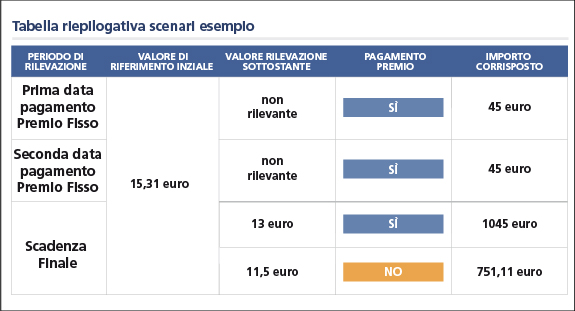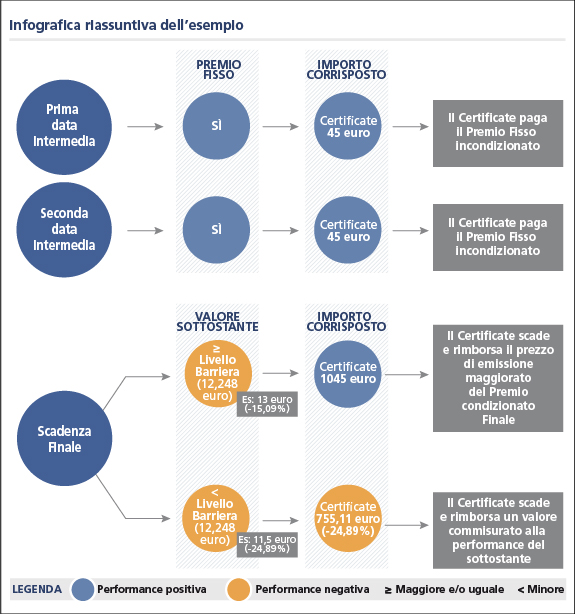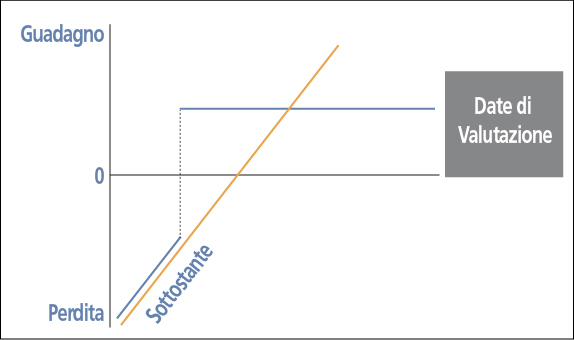Premium Certificate

Cosa sono i Premium Certificate
I Premium Certificate sono strumenti finanziari che permettono di investire su un’attività finanziaria sottostante, quale ad esempio un’azione, un indice azionario, una valuta, una materia prima o un tasso di interesse. La loro peculiarità è quella di distribuire nel corso della vita del Certificate dei premi fissi, indipendentemente dall’andamento dell’attività sottostante. Alla scadenza del Certificate all’investitore sarà restituito il prezzo di emissione maggiorato di un premio, se l’attività sottostante avrà un valore superiore o uguale ad un determinato livello fissato in fase di emissione, chiamato Livello Barriera. Se il sottostante, a scadenza, avrà un valore inferiore al Livello Barriera, il Certificate rimborserà un importo commisurato alla performance del sottostante: l’investitore subirà conseguentemente una perdita pari a quella che avrebbe ottenuto investendo direttamente nell’attività sottostante.
A chi si rivolgono i Premium Certificate
I Premium Certificate sono strumenti rivolti ad investitori con aspettative rialziste, di stabilità o moderato ribasso (nel caso di Premium Long) del valore dell’attività finanziaria sottostante. Il capitale investito nei Premium Certificate è protetto solo se a scadenza il sottostante non scende sotto un certo livello, determinato in percentuale rispetto al valore di riferimento iniziale (esempio l’80%), chiamato Livello Barriera.
Quotazione e negoziazione dei Premium Certificate
I Premium Certificate sono strumenti finanziari che, in Italia, possono essere acquistati o venduti sui sistemi multilaterali di negoziazione SeDeX e EuroTLX di Borsa Italiana. Le modalità e orari di negoziazione presso tali sistemi multilaterali di negoziazione sono specificati nei relativi regolamenti disponibili sul sito internet di Borsa Italiana. Ad esempio, le negoziazioni continue possono avvenire nei giorni di mercato aperto dalle 9:05 alle 17:30 sul SeDeX e dalle 9:00 alle 17:30 su EuroTLX.
Caratteristiche dei Premium Certificate
- SOTTOSTANTE: ossia l’azione, l’indice azionario, la valuta, la materia prima o qualsiasi altro strumento finanziario o reale da cui dipende il valore del Certificate;
- VALORE DI RILEVAZIONE INIZIALE o STRIKE PRICE: ossia il prezzo di rilevazione iniziale dell’attività sottostante rilevato nella data prefissata in fase di emissione del Certificate;
- LIVELLO BARRIERA: ossia il valore o prezzo del sottostante sotto il quale l’investitore perde la protezione del capitale;
- SCADENZA: ossia la data in cui il Certificate cessa di esistere;
- EMITTENTE: ossia l’istituzione finanziaria che ha emesso il Certificate;
- LOTTO MINIMO: ossia il numero minimo di Certificate che possono essere acquistati o venduti;
- ISIN: ossia il codice alfanumerico che identifica in modo univoco lo strumento finanziario;
- PREMIO FISSO (INCONDIZIONATO): ossia il premio distribuito all’investitore indipendentemente dall’andamento del sottostante;
- PREMIO A SCADENZA (CONDIZIONATO): ossia il premio distribuito a scadenza in caso di mancato superamento del Livello Barriera;
- MULTIPLO: ossia la quantità di sottostante controllata da ciascun Certificate e pari al rapporto tra il prezzo di sottoscrizione in fase di emissione del Certificate e il Valore di Riferimento Iniziale dell’attività finanziaria sottostante;
Funzionamento dei Premium Certificate
Durante la vita del Certificate, i Premium Certificate prevedono la distribuzione di Premi Fissi indipendentemente dall’andamento dell’attività finanziaria sottostante. Il pagamento di questi premi avviene a date prestabilite fissate in fase di emissione del Certificate. Alla scadenza dello strumento finanziario sono due i possibili scenari che si possono manifestare all’investitore:
- il valore finale dell’attività finanziaria sottostante è maggiore o uguale del Livello Barriera: in questo caso il Certificate rimborsa il prezzo di emissione maggiorato di un premio prefissato;
- il valore finale dell’attività finanziaria sottostante è minore del Livello Barriera: in questo caso l’investitore riceve un importo di rimborso correlato con l’andamento del sottostante e quindi pari a quello che avrebbe ottenuto investendo direttamente nell’attività sottostante.
Esempio di funzionamento
Si ipotizzi un Premium Certificate con sottostante il titolo azionario Eni e avente le seguenti caratteristiche:
| Scadenza | 2 anni |
|---|---|
| Prezzo di emissione | 1000€ |
| Data di rilevazione iniziale | 27/11/2015 |
| Valore di riferimento iniziale | 15,31 € |
| Premi fissi incondizionati | 45 € |
| Data di pagamento premio fisso incondizionato | 27/05/2016 |
| Data di pagamento secondo premio fisso incondizionato | 28/11/2016 |
| Data di rilevazione finale | 27/11/2017 |
| Premio a scadenza condizionato | 45 € |
| Multiplo | 6,53168 |
| Livello Barriera | 12,248 € (pari all'80% del Valore di riferimento iniziale) |
Il 27 maggio e il 28 novembre del 2016 il prodotto distribuirà un premio di 45 euro per ogni Certificate sottoscritto (totale 90 euro). A scadenza sono due i possibili scenari che si prospettano all’investitore:
- l’azione Eni quota a un livello pari o superiore al Livello Barriera (12,248 euro). Per esempio, se Eni vale 13 euro l’investitore riceve il prezzo di emissione di 1000 euro più 45 euro per un totale di 1045,0 euro per ogni Certificate sottoscritto;
- l’azione Eni quota a un livello inferiore al Livello Barriera (12,248 euro). Per esempio, se Eni vale 11,5 euro l’investitore perde la protezione condizionata del capitale registrando una perdita. L’attività finanziaria sottostante ha registrato una performance negativa del 24,89%. Di conseguenza, per ogni Certificate detenuto, all’investitore saranno corrisposti 751,11 euro. Si tratta dello stesso importo che sarebbe stato possibile ottenere tramite l’investimento diretto nell’attività sottostante, ma tramite il Premium Certificate le perdite sono attenuate dai premi (90 euro) incassati precedentemente. Tramite l’utilizzo del Premium Certificate, l’investitore invece che subire una perdita del 24,89% legata all’andamento del sottostante accuserebbe una perdita complessiva del 15,89%.


Esempio grafico payoff Premium Certificate

Per approfondimenti sui termini è possibile consultare l' apposito GLOSSARIO